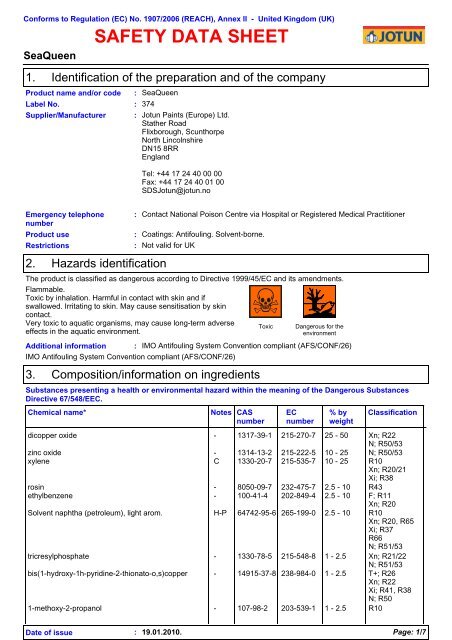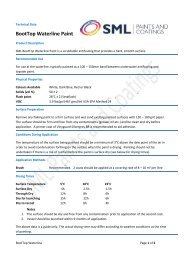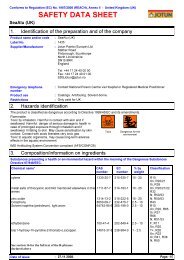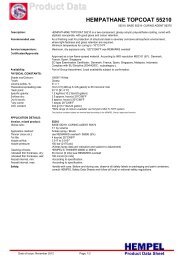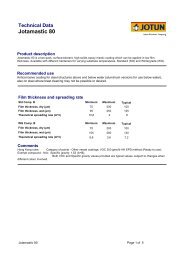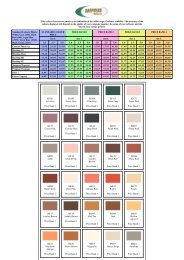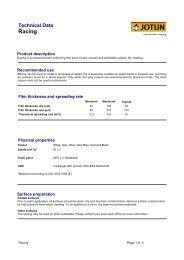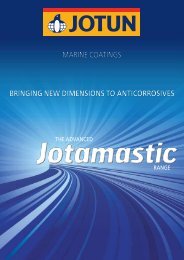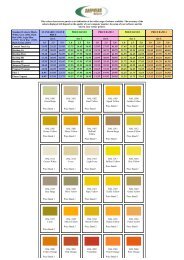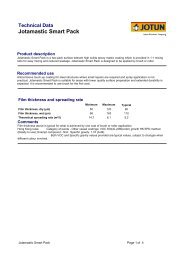safety data sheet - Jotun Marine Paint-Jotun Boat Paint & Antifouling
safety data sheet - Jotun Marine Paint-Jotun Boat Paint & Antifouling
safety data sheet - Jotun Marine Paint-Jotun Boat Paint & Antifouling
- No tags were found...
You also want an ePaper? Increase the reach of your titles
YUMPU automatically turns print PDFs into web optimized ePapers that Google loves.
Conforms to Regulation (EC) No. 1907/2006 (REACH), Annex II - United Kingdom (UK)SeaQueen1.SAFETY DATA SHEETIdentification of the preparation and of the companyProduct name and/or code :Label No. : 374Supplier/Manufacturer:SeaQueen<strong>Jotun</strong> <strong>Paint</strong>s (Europe) Ltd.Stather RoadFlixborough, ScunthorpeNorth LincolnshireDN15 8RREnglandTel: +44 17 24 40 00 00Fax: +44 17 24 40 01 00SDS<strong>Jotun</strong>@jotun.noEmergency telephonenumberProduct useRestrictions2.::Contact National Poison Centre via Hospital or Registered Medical PractitionerCoatings: <strong>Antifouling</strong>. Solvent-borne.: Not valid for UKHazards identificationThe product is classified as dangerous according to Directive 1999/45/EC and its amendments.Flammable.Toxic by inhalation. Harmful in contact with skin and ifswallowed. Irritating to skin. May cause sensitisation by skincontact.Very toxic to aquatic organisms, may cause long-term adverseeffects in the aquatic environment.Additional information : IMO <strong>Antifouling</strong> System Convention compliant (AFS/CONF/26)IMO <strong>Antifouling</strong> System Convention compliant (AFS/CONF/26)3.Composition/information on ingredientsToxicDangerous for theenvironmentSubstances presenting a health or environmental hazard within the meaning of the Dangerous SubstancesDirective 67/548/EEC.Chemical name*NotesCASnumberECnumber% byweightClassificationdicopper oxide - 1317-39-1 215-270-7 25 - 50 Xn; R22N; R50/53zinc oxide - 1314-13-2 215-222-5 10 - 25 N; R50/53xylene C 1330-20-7 215-535-7 10 - 25 R10Xn; R20/21Xi; R38rosin - 8050-09-7 232-475-7 2.5 - 10 R43ethylbenzene - 100-41-4 202-849-4 2.5 - 10 F; R11Xn; R20Solvent naphtha (petroleum), light arom. H-P 64742-95-6 265-199-0 2.5 - 10 R10Xn; R20, R65Xi; R37R66N; R51/53tricresylphosphate - 1330-78-5 215-548-8 1 - 2.5 Xn; R21/22N; R51/53bis(1-hydroxy-1h-pyridine-2-thionato-o,s)copper - 14915-37-8 238-984-0 1 - 2.5 T+; R26Xn; R22Xi; R41, R38N; R501-methoxy-2-propanol - 107-98-2 203-539-1 1 - 2.5 R10Date of issue : 19.01.2010.Page: 1/7
SeaQueenSee section 16 for the full text of the R-phrasesdeclared aboveOccupational exposure limits, if available, are listed in section 8.4.First-aid measuresFirst-aid measuresGeneralInhalationSkin contactEye contactIngestion:::::In all cases of doubt, or when symptoms persist, seek medical attention. Never giveanything by mouth to an unconscious person. If unconscious, place in recoveryposition and seek medical advice.Remove to fresh air. Keep person warm and at rest. If not breathing, if breathing isirregular or if respiratory arrest occurs, provide artificial respiration or oxygen bytrained personnel.Remove contaminated clothing and shoes. Wash skin thoroughly with soap andwater or use recognised skin cleanser. Do not use solvents or thinners.Check for and remove any contact lenses. Immediately flush eyes with running waterfor at least 15 minutes, keeping eyelids open.If swallowed, seek medical advice immediately and show the container or label.Keep person warm and at rest. Do not induce vomiting.5.Fire-fighting measuresExtinguishing media :Extinguishing media not tobe usedRecommendationsPersonal precautionsRecommended: alcohol-resistant foam, CO2, powders, water spray.: Do not use water jet.6. Accidental release measures: Fire will produce dense black smoke. Exposure to decomposition products maycause a health hazard. Appropriate breathing apparatus may be required.Cool closed containers exposed to fire with water. Do not release runoff from fire todrains or watercourses.:Exclude sources of ignition and ventilate the area. Avoid breathing vapour or mist.Refer to protective measures listed in sections 7 and 8. Contain and collect spillagewith non-combustible, absorbent material e.g. sand, earth, vermiculite ordiatomaceous earth and place in container for disposal according to local regulations(see section 13).Spill: Preferably clean with a detergent. Avoid using solvents.Note: see section 8 for personal protective equipment and section 13 for waste disposal.7.Handling and storageHandling:Vapours are heavier than air and may spread along floors. Vapours may formexplosive mixtures with air. Prevent the creation of flammable or explosiveconcentrations of vapours in air and avoid vapour concentrations higher than theoccupational exposure limits.In addition, the product should only be used in areas from which all naked lights andother sources of ignition have been excluded. Electrical equipment should beprotected to the appropriate standard.To dissipate static electricity during transfer, earth drum and connect to receivingcontainer with bonding strap. Operators should wear antistatic footwear and clothingand floors should be of the conducting type.Keep container tightly closed. Keep away from heat, sparks and flame. No sparkingtools should be used.Avoid contact with skin and eyes. Avoid the inhalation of dust, particulates, spray ormist arising from the application of this preparation. Avoid inhalation of dust fromsanding.Eating, drinking and smoking should be prohibited in areas where this material ishandled, stored and processed.Put on appropriate personal protective equipment (see section 8).Never use pressure to empty. Container is not a pressure vessel.Always keep in containers made from the same material as the original one.Comply with the health and <strong>safety</strong> at work laws.When operators, whether spraying or not, have to work inside the spray booth,Date of issue : 19.01.2010.Page: 2/7
SeaQueenventilation is unlikely to be sufficient to control particulates and solvent vapour in allcases. In such circumstances they should wear a compressed air-fed respiratorduring the spraying process and until such time as the particulates and solventvapour concentration has fallen below the exposure limits.Storage:Store in accordance with local regulations. Observe label precautions. Store in a dry,cool and well-ventilated area. Keep away from heat and direct sunlight.Keep away from sources of ignition. Keep away from: oxidising agents, strongalkalis, strong acids.No smoking. Prevent unauthorised access. Containers that have been opened mustbe carefully resealed and kept upright to prevent leakage. Do not empty into drains.8. Exposure controls/personal protectionEngineering measuresLower explosion limitxyleneethylbenzeneSolvent naphtha (petroleum), lightarom.bis(1-hydroxy-1h-pyridine-2-thionatoo,s)copper1-methoxy-2-propanol:Provide adequate ventilation. Where reasonably practicable, this should be achievedby the use of local exhaust ventilation and good general extraction. If these are notsufficient to maintain concentrations of particulates and solvent vapours below theOEL, suitable respiratory protection must be worn.Occupational exposure limitsEH40/2005 WELs (United Kingdom (UK), 8/2007). Absorbedthrough skin.STEL: 441 mg/m³ 15 minute(s).STEL: 100 ppm 15 minute(s).TWA: 220 mg/m³ 8 hour(s).TWA: 50 ppm 8 hour(s).EH40/2005 WELs (United Kingdom (UK), 8/2007). Absorbedthrough skin.STEL: 552 mg/m³ 15 minute(s).STEL: 125 ppm 15 minute(s).TWA: 100 ppm 8 hour(s).TWA: 441 mg/m³ 8 hour(s).EH40-WEL (United Kingdom (UK), 1/2005).TWA: 125 mg/m³ 8 hour(s). Form: All formsTWA: 25 ppm 8 hour(s). Form: All formsArch Chemicals (Europe, 2002).TWA: 0,35 mg/m³ 8 hour(s).EH40/2005 WELs (United Kingdom (UK), 8/2007). Absorbedthrough skin.STEL: 560 mg/m³ 15 minute(s).STEL: 150 ppm 15 minute(s).TWA: 375 mg/m³ 8 hour(s).TWA: 100 ppm 8 hour(s).Personal protective equipmentRespiratory system :Skin and body:Hands:If workers are exposed to concentrations above the exposure limit, they must useappropriate, certified respirators. Use respiratory mask with charcoal and dust filterwhen spraying this product.(as filter combination A2-P3). In confined spaces, usecompressed-air or fresh-air respiratory equipment. When use of roller or brush,consider use of charcoalfilter.Personnel should wear antistatic clothing made of natural fibres or of hightemperature-resistantsynthetic fibres.Wear suitable gloves.Eyes:May be used, gloves(breakthrough time) 4 - 8 hours: neoprene, butyl rubberNot recommended, gloves(breakthrough time) < 1 hour: PVCRecommended, gloves(breakthrough time) > 8 hours: fluor rubber, Viton, polyvinylalcohol (PVA), nitrile rubber, Teflon, 4HFor right choice of glove materials, with focus on chemical resistance and time ofpenetration, seek advice by the supplier of chemical resistant gloves.The user must check that the final choice of type of glove selected for handling thisproduct is the most appropriate and takes into account the particular conditions ofuse, as included in the user's risk assessment.Use <strong>safety</strong> eyewear designed to protect against splash of liquids.Date of issue : 19.01.2010.Page: 3/7
SeaQueen9.Physical and chemical propertiesPhysical state: Liquid.Odour: Characteristic.Colour: Various colours.Flash point: Closed cup: 30°C (86°F)Density : 1.7 g/cm 3Explosion limits : 1.1 - 13.7%Ingredient name: Insoluble in the following materials: cold water and hot water.10.Stability and reactivityStable under recommended storage and handling conditions (see section 7).Hazardous decomposition products: carbon monoxide, carbon dioxide, smoke, oxides of nitrogen.Keep away from the following materials to prevent strong exothermic reactions: oxidising agents, strong alkalis, strongacids.11.Toxicological informationThere is no <strong>data</strong> available on the preparation itself. The preparation has been assessed following the conventionalmethod of the Dangerous Preparations Directive 1999/45/EC and classified for toxicological hazards accordingly. Seesections 2 and 15 for details.Exposure to component solvent vapour concentrations in excess of the stated occupational exposure limit may result inadverse health effects such as mucous membrane and respiratory system irritation and adverse effects on the kidneys,liver and central nervous system. Solvents may cause some of the above effects by absorption through the skin.Symptoms and signs include headache, dizziness, fatigue, muscular weakness, drowsiness and, in extreme cases, lossof consciousness. Repeated or prolonged contact with the preparation may cause removal of natural fat from the skin,resulting in non-allergic contact dermatitis and absorption through the skin. If splashed in the eyes, the liquid may causeirritation and reversible damage. Swallowing may cause nausea, diarrhoea, vomiting, gastro-intestinal irritation andchemical pneumonia.Contains: rosin. May produce an allergic reaction.12.Ecological informationThere is no <strong>data</strong> available on the preparation itself.Do not allow to enter drains or watercourses.The preparation has been assessed following the conventional method of the Dangerous Preparations Directive1999/45/EC and is classified for eco-toxicological properties accordingly. See Sections 3 and 15 for details.Aquatic ecotoxicityProduct/ingredient name Test ResultSpecies Exposuredicopper oxide Mortality Acute EC50 0,042 mg/LFresh waterDaphnia -Water flea -Daphniasimilis - 6 to24 hours48 hoursMortalityAcute LC50 0,075 mg/LFresh waterzinc oxide Intoxication Acute EC50 >1000 ppmFresh waterMortality Acute LC50 1,1 to 2,5ppm Fresh waterxylene Mortality Acute LC50 12000 to16114 ug/L Fresh waterFish - Zebradanio - DaniorerioDaphnia -Water flea -Daphniamagna -
SeaQueenmacrochirus -1,1 gethylbenzene Population Acute EC50 7,2 mg/L Algae 48 hoursIntoxication Acute EC50 2,93 mg/L Daphnia 48 hoursMortality Acute LC50 4,2 mg/L Fish 96 hoursSolvent naphtha (petroleum), light arom. - Acute EC50
SeaQueenADR / RIDIMDG: Tunnel restriction code: (E)Hazard identification number: 63: Emergency schedules (EmS): F-E, S-D<strong>Marine</strong> pollutant: Yes.Transport in accordance with ADR/RID, IMDG/IMO and ICAO/IATA and national regulation.15.Regulatory informationEU regulationsHazard symbol or symbols: The product is classified and labelled for supply in accordance with the Directive1999/45/EC as follows::Risk phrasesSafety phrasesContains:Additional informationIndustrial use::ToxicDangerous for theenvironmentR10- Flammable.R23- Toxic by inhalation.R21/22- Harmful in contact with skin and if swallowed.R38- Irritating to skin.R43- May cause sensitisation by skin contact.R50/53- Very toxic to aquatic organisms, may cause long-term adverse effects in theaquatic environment.S23- Do not breathe vapour / spray.S36/37- Wear suitable protective clothing and gloves.S38- In case of insufficient ventilation, wear suitable respiratory equipment.S45- In case of accident or if you feel unwell, seek medical advice immediately(show the label where possible).: dicopper oxidexylenerosinbis(1-hydroxy-1h-pyridine-2-thionato-o,s)copper: IMO <strong>Antifouling</strong> System Convention compliant (AFS/CONF/26)This product does not contain organotin compounds acting as biocides and complieswith the International Convention on the Control of Harmful Anti-fouling Systems onShips as adopted by IMO in October 2001 (IMO document AFS/CONF/26).: The information contained in this <strong>safety</strong> <strong>data</strong> <strong>sheet</strong> does not constitute the user’sown assessment of workplace risks, as required by other health and <strong>safety</strong>legislation. The provisions of the national health and <strong>safety</strong> at work regulations applyto the use of this product at work.16.Other informationCEPE Classification : 1Full text of R-phrasesreferred to in sections 2 and3 - United Kingdom (UK):R11- Highly flammable.R10- Flammable.R26- Very toxic by inhalation.R23- Toxic by inhalation.R20- Harmful by inhalation.R22- Harmful if swallowed.R20/21- Harmful by inhalation and in contact with skin.R21/22- Harmful in contact with skin and if swallowed.R65- Harmful: may cause lung damage if swallowed.R41- Risk of serious damage to eyes.R37- Irritating to respiratory system.R38- Irritating to skin.R43- May cause sensitisation by skin contact.R66- Repeated exposure may cause skin dryness or cracking.R50- Very toxic to aquatic organisms.R50/53- Very toxic to aquatic organisms, may cause long-term adverse effects in theaquatic environment.R51/53- Toxic to aquatic organisms, may cause long-term adverse effects in theaquatic environment.The information in this Safety Data Sheet is required pursuant to EU Directive 91/155/EEC and its amendments.Date of issue : 19.01.2010.Page: 6/7
SeaQueenDate of issue : 19.01.2010.Version: 4Indicates information that has changed from previously issued version.Notice to readerThe information in this SDS is based on the present state of our knowledge and on current laws. The productis not to be used for purposes other than those specified under section 1 without first obtaining writtenhandling instructions. It is always the responsibility of the user to take all necessary steps to fulfil thedemands set out in the local rules and legislation. The information in this SDS is meant to be a description ofthe <strong>safety</strong> requirements for our product. It is not to be considered a guarantee of the product's properties.Date of issue : 19.01.2010.Page: 7/7


